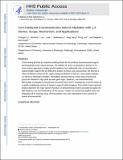CuH-Catalyzed Enantioselective Ketone Allylation with 1,3-Dienes: Scope, Mechanism, and Applications
Author(s)
Li, Chengxi; Liu, Richard Y.; Jesikiewicz, Luke T.; Yang, Yang; Liu, Peng; Buchwald, Stephen L.; ... Show more Show less
DownloadAccepted version (1.179Mb)
Publisher Policy
Publisher Policy
Article is made available in accordance with the publisher's policy and may be subject to US copyright law. Please refer to the publisher's site for terms of use.
Terms of use
Metadata
Show full item recordAbstract
Chiral tertiary alcohols are important building blocks for the synthesis of pharmaceutical agents and biologically active natural products. The addition of carbon nucleophiles to ketones is the most common approach to tertiary alcohol synthesis but traditionally relies on stoichiometric organometallic reagents that are difficult to prepare, sensitive, and uneconomical. We describe a mild and efficient method for the copper-catalyzed allylation of ketones using widely available 1,3-dienes as allylmetal surrogates. Homoallylic alcohols bearing a wide range of functional groups are obtained in high yield and with good regio-, diastereo-, and enantioselectivity. Mechanistic investigations using density functional theory (DFT) implicate the in situ formation of a rapidly equilibrating mixture of isomeric copper(I) allyl complexes, from which Curtin-Hammett kinetics determine the major isomer of the product. A stereochemical model is provided to explain the high diastereo- and enantioselectivity of this process. Finally, this method was applied to the preparation of an important drug, (R)-procyclidine, and a key intermediate in the synthesis of several pharmaceuticals. ©2019
Date issued
2019-02Department
Massachusetts Institute of Technology. Department of ChemistryJournal
Journal of the American Chemical Society
Publisher
American Chemical Society (ACS)
Citation
Li, Chengxi, et al., "CuH-Catalyzed Enantioselective Ketone Allylation with 1,3-Dienes: Scope, Mechanism, and Applications." Journal of the American Chemical Society 141, 12 (February 2019): p. 5062-70 doi 10.1021/JACS.9B01784 ©2019 Author(s)
Version: Author's final manuscript
ISSN
1520-5126
0002-7863